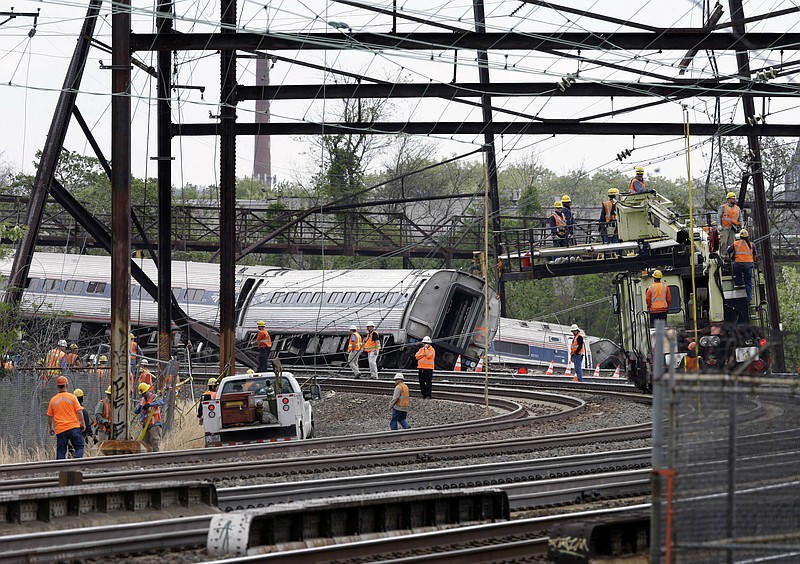Why does it always take a disaster to get our leaders seriously talking about fixing -- and raising money to fix -- our aging infrastructure? Why dies it always take a crash like the Amtrak derailment to get us calling for serious improvements in workplace safety?
And more importantly, why does not even a disaster get those tasks done?
Even as federal investigators and first-responders picked through the debris of the Amtrak train that derailed Tuesday night, the U.S. House Appropriations Committee voted Wednesday to reject increased funding for the rail service to make capital improvements.
Rep. Chaka Fattah, D-Penn., proposed a boost that was rejected by the Republican-led committee on a 30-21 vote as the panel marked up a transportation funding bill. Instead, Republican budget hawks decided to move forward with further cuts after arguing that specific funding increases like one for sought for Amtrak must be offset by cuts elsewhere.
At least eight people died and more than were injured in the crash. There were reportedly 238 passengers and five crew members aboard the train that NTSB confirmed was traveling in excess of 100 mph in an area where it should have been slowed to about 50 mph.
Yet the House's appropriations panel marked up a transportation funding bill to reduce grants to Amtrak by $252 million -- a drop of about 15 percent from last year's $1.4 billion. The cut is in capital for Amtrak, which would pay for broader improvements, including "positive train control," a technology that could have prevented the accident.
Rep. Fattah had requested a bump to $2.4 billion for Amtrak, and President Barack Obama had sought that amount in his budget.
About three months ago, President Barack Obama unveiled a budget calling for a new wave of infrastructure spending worth $478 billion over six years. Some Republicans supported the call to spend more on roads and the like, at least in principle.
After all, it's generally accepted thinking that infrastructure improvements are solid ways to fuel economic growth, especially when projects are focused and lead to new markets. The Hoover Dam provided electricity to the West. The Erie Canal opened the Midwest to global trade.
Sure, there are other projects that have yielded fewer benefits: The Tennessee-Tombigbee Waterway, for instance. The $2 billion, 234-mile canal fell far short of its expected usage until 1988 when drought closed the Mississippi River and shifted barge traffic to the Tenn-Tom. Since then, its use has increased.
But the Washington-based Progressive Policy Institute concludes that every dollar spent on U.S. roads, bridges and public transport spurs $1.50 to $2 of growth.
More importantly, ignoring our needs -- both infrastructure needs and worker safety issues -- has led to numerous dangerous and tragic accidents.
Remember the deadly failure of the I-35W bridge in Minneapolis that killed 13 people in 2007? The collapse inspired a bipartisan populist outcry. Americans demanded shovel-ready projects and, specifically, progress toward repairing the thousands of structurally deficient bridges around the country. But five years later, the crisis had reverted to a nagging sense of dread, and infrastructure is back where it was -- and is -- on the back burner.
In 2013, of the 604,493 bridges in the U.S., 66,405 bridges or 11 percent were structurally deficient, and one in nine require significant repairs, maintenance or replacement. U.S. bridges are, on average, 43 years old, and the average age of the structurally deficient ones is 65 years. More than $76 billion is needed to address repair and replacement. For decades, we had a dedicated bridge repair fund, but in 2012 Congress eliminated it.
Then there are the outdated sewer and wastewater systems -- like Chattanooga's -- which overflow after heavy rains, resulting in untreated sewage flowing into rivers, lakes, and streams, contaminating drinking water sources and creating other health hazards.
And don't forget the crumbling and still-stalled Chickamauga Dam replacement.
The federal government sets transit and highway policies and funding levels for the country through the surface transportation authorization laws, generally in six-year cycles. But since 2009, Congress has funded transportation through a dozen short-term measures, ranging from one week to two years. On May 31, the current transportation authorization bill -- the Moving Ahead for Progress in the 21st Century Act of 2012, or MAP-21 -- is set to expire. Shortly thereafter, the Highway Trust Fund, which invests about $50 billion annually, will run out of money to cover the federal share of urgently needed roadway, bridge and transit projects in cities and states across the country.
In 2013, the American Society of Civil Engineers estimated that roughly $3.6 trillion in total investment is needed by 2020 to return the nation's facilities to good repair.
That's a far cry from the president's call for $478 billion over the next six years, but it further still from the slashed budgets Republicans are looking for as they also call for greater tax breaks for the wealthy and for corporations.
We must invest in our infrastructure. It is is an investment both in safety, in our workers and in our commerce.
